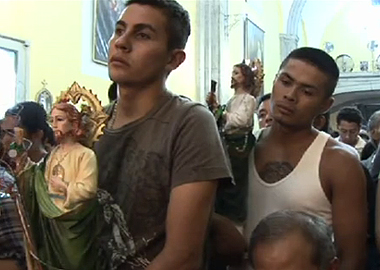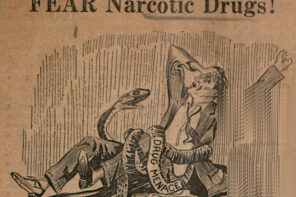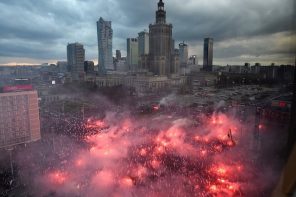The mood in Cuernavaca was subdued last week after four decapitated bodies were discovered, hung from their feet from an overpass in yet another set of drug-related assassinations. Turf battles between rival drug cartels have plagued the once-tranquil “city of eternal spring” since December of 2009, when the Marines took out the drug kingpin, Arturo Beltran Leyva, and then offered for public display his stripped, bullet-riddled body, adorned with dollars, rosaries, and small religious medals they had taken from his pockets.
For more than twenty years, in the 1970s and 1980s, this same city was one of the most important centers for Roman Catholic Liberation Theology in Latin America. Now, today, after two decades of a conservative turn orchestrated by Rome, the Diocese of Cuernavaca, and the Mexican Church more generally, has been rendered impotent to address the complex social and economic problems that underlie the traffic in drugs. Meanwhile, violence has only escalated under Mexican President Calderon’s drug war, with the total dead now approaching 30,000 in a little over three years. Among other recent victims are 72 migrants found on August 24th on a farm in a remote town just 100 miles south of the US border.
Dismantling the Liberationist Legacy
Liberation Theology, the radical social and theological experiment launched after the Second Vatican Council, offered both a social critique and a utopian vision for the future of Latin America. This project was, for a time, powerful and pervasive enough that it could have mitigated some of the underlying social problems that today create fertile ground for drug-based economies and narco-violence throughout Latin America.
The liberationist vision was taken up nowhere else more seriously as by the Diocese of Cuernavaca, under the leadership of the beloved “red bishop,” don Segio Méndez Arceo. Don Sergio saw that his priests were trained as community organizers, not in seminaries but rather in the “colonias populares” in the impoverished outskirts of Cuernavaca, where they were immersed in the lives and the struggles of the poor of the Diocese. Under the leadership of these liberationist priests, communities throughout the region mobilized around a Christian-informed political activism in a struggle for economic justice.
In 1981, Don Sergio famously excommunicated torturers and human rights violators. He was forced into retirement shortly thereafter, after thirty years as bishop, and quickly replaced by a succession of politically and theological conservative bishops who went about the work of dismantling and undermining don Sergio’s liberationist legacy. Today, little remains of his social vision and practice, and the aging priests who once embraced it cast to the margins of the diocese. This is a pattern that was enacted elsewhere in Mexico and throughout Latin America in the last decades of the twentieth century, as the Vatican worked the institutional dismantling of liberation theology. The Mexican Church has so distanced itself from the grassroots that it no longer has the authority and credibility it once had to launch an effective analysis and critique, or to propose credible alternatives to the recent drug war. In a recent interview, novelist Vincete Linero, author of The Crime of Padre Amaro, asserted that if the Church had persisted in its liberationist social vision “we would not now be seeing this wave of crimes in which the druglords have taken over Cuernavaca.”*
Spiritual Money Laundering
The Church also has been widely criticized by Mexican journalists for accepting “narcolimosnas,” or drug-tithes, from the big cartels. Last year, one Mexican bishop boldly defended his right to accept these “donations”, saying that they helped fund the construction of many churches—in effect arguing for a sort of spiritual money laundering. In an effort to respond to such public concerns, the current bishop of Cuernavaca gently suggested to his diocesan priests that they refrain from presiding at the plush religious celebrations of wealthy drug barons, including private confirmations, first communions, weddings, and other “narcosacraments.”
Faced with escalating violence and having largely abandoned its’ social commitment, the Church, for the most part, has retreated from its persecuted flock. Many churches along the border now prefer to close their doors early, or open only briefly for Mass. Protestant churches have also withdrawn from these areas: US evangelical churches have pulled out almost entirely from border mission trips. This is not to say that there are not outspoken and committed clergy on the frontlines defending their congregations: indeed, priests who have dared to criticize the drug cartels have lost their lives. But these men remain on the margins of the church. From these margins, some progressive-minded priests have opposed Calderon’s drug war, arguing that it has only increased violence. Instead, they believe the government should enter into peace negotiations with the big drug cartels, in search of something analogous to the Salvadoran Peace Accords reached in 1992.
A Place of Death and Dying
The global public, confronted with the spectacle of this violence, has responded with a morbid and anxious curiosity, on the one hand, and a mute indifference on the other. Perhaps this should come as no surprise. Mexico has long been a place of violence, death and dying in the Western imagination. From Hernan Cortez’s horror at the bodies of sacrificial victims (a horror that blinded the conquistadors to their own acts of violence), to the famed sixteenth-century friar Bartolomé de las Casas’ account of Spanish atrocities worked upon innocent indigenous bodies in the process of conquest, to the accrued corpses of populations laid waste by European-born epidemic disease through three centuries of colonial rule—Mexicans in some sense have been understood as “born to die” violent, brutal and untimely deaths.
The ritual and public display of the mutilated bodies of victims of narcoviolence are thus like so many sacrificial victims cast down down the steps of the great Templo Mayor of the Aztec capital Tenochtitan (in fact, the Aztec City has today been re-dubbed “Narcotitlan”, as one Mexico City graffito declares). In both instances, the images of violence evoke horror, not compassion, in the western viewer. Violence in Mexico is thus naturalized and routinized—the grim backdrop for nightmarish dystopias represented in Hollywood films. With the Church, the state, and the global public impotent or simply unwilling to protect them, many of Mexico’s faithful have turned to so called “narcosaints.”
From San La Muerte to Jesús Malverde to San Judas Tadeo, these marginal saints offer their protection to all of those made vulnerable by the current “narcoculture”: drug addict, drug trafficker, and police officer alike.
* (Jorge Sifuentes Cañas, “Marcial Maciel era un sujto de psicoanálisis: Vincente Leñero”, El Milenio, Miércoloes 4 de Agosto de 2010)





